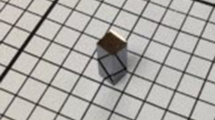Abstract
Cadmium zinc telluride (Cd1−x ZnxTe or CZT) has shown great promise as a material for room temperature x-ray and gamma-ray detectors. In particular, polycrystalline material grown by the high pressure Bridgman method with nominal Zn fraction (x) from 0.1 to 0.2 has been used to fabricate high resolution gamma-ray spectrometers with resolution approaching that of cooled high-purity Ge. For increased sensitivity, large areas (> 1 cm2) are required, and for good sensitivity to high energy gamma photons, thick detectors (on the order of 1 cm) are required. Thus, there has been a push for the development of CZT detectors with a volume greater than 1 cm3. However, nonuniformities in the material over this scale degrade the performance of the detectors. Variations in the zinc fraction, and thus the bandgap, and changes in the impurity distributions, both of which arise from the selective segregation of elements during crystal growth, result in spectral distortions. In this work, several materials characterization techniques were combined with detector evaluations to determine the materials properties limiting detector performance. Materials measurements were performed on detectors found to have differing performance. Measurements conducted include infrared transmission, particle induced x-ray emission, photoluminescence, and triaxial x-ray diffraction. To varying degrees, these measurements reveal that “poor-performance” detectors exhibit higher nonuniformities than “spectrometer-grade” detectors. This is reasonable, as regions of CZT material with different properties will give different localized spectral responses, which combine to result in a degraded spectrum for the total device.
Similar content being viewed by others
References
F.P. Doty, J.F. Butler, J.F. Schetzina and K.A. Bowers,J. Vac. Sci. Technol. B 10, 1418 (1992).
J.F. Butler, C.L. Lingren and F.P. Doty,IEEE Trans Nucl. Phys. 39, 605 (1992).
R.B. James, T.E. Schlesinger, J. Lund and M. Schieber,Semiconductors for Room Temperature Nuclear Detector Applications, Vol. 43 of Semiconductors and Semimetals (Academic Press, 1995), Chap. 9.
J.C. Lund, J.M. Van Scyoc, R.B. James, D.S. McGregor and R.W. Olsen,9th Intl. Workshop on Room-Temperature Semi-conductorX- and fray Detectors, Associated Electronics, and Applications, September 20, 1995, Grenoble, France, to appear inNucl. Instr. and Meth. A.
J.C. Lund, R.W. Olsen, J.M. Van Scyoc and R.B. James,IEEE 1995 Nuclear Sci. Symp., October 24, 1995, San Francisco, CA, to appear inNucl. Instr. and Meth. A.
J.E. Toney, B.A. Brunett, T.E. Schlesinger, J.M. Van Scyoc, R.B. James, M. Schieber, M. Goorsky, H. Yoon, E. Eissler and C. Johnson,9th Intl. Workshop on Room-Temperature Semi-conductor X- and y-ray Detectors, Associated Electronics, and Applications, September 20, 1995, Grenoble, France, to appear inNucl. Instr. and Meth. A.
J. Gonzalez-Hernandez, E. Lopez-Cruz, D.D. Allredand, W.P. Allred,J. Vac. Sci. Tech. A 8, 3255 (1987).
Author information
Authors and Affiliations
Rights and permissions
About this article
Cite this article
Van Scyoc, J.M., Lund, J.C., Morse, D.H. et al. Material inhomogeneities in Cd1-xZnxTe and their effects on large volume gamma-ray detectors. J. Electron. Mater. 25, 1323–1327 (1996). https://doi.org/10.1007/BF02655027
Received:
Revised:
Issue Date:
DOI: https://doi.org/10.1007/BF02655027




